AI Art in Creative Portfolios: How Hiring Managers Can Spot Real Talent
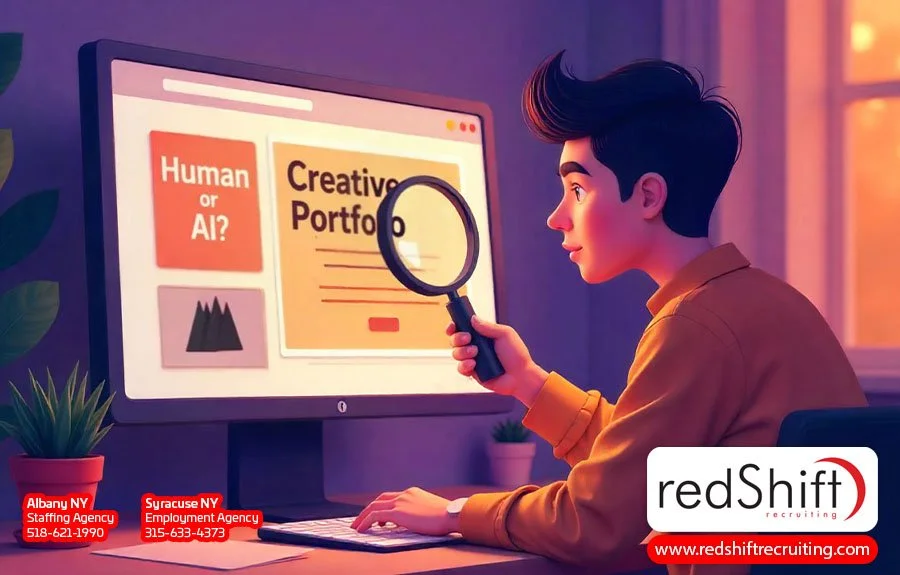
Creative portfolios have always been the go-to way to judge a designer’s talent. They showcase not just what someone has made, but how they think, solve problems, and bring ideas to life.
But now, as AI image generators grow more powerful and capable of producing polished, professional-looking work, employers face a new challenge. How do you know if a candidate truly has the skills your role requires, or if their portfolio leans too heavily on AI? And if AI is in the mix, does that automatically mean they aren’t qualified—or could it actually be a sign of adaptability?
This blog post breaks down what hiring managers need to know about AI art in creative portfolios: how it shows up, why human skills still matter, the green and red flags to watch for, and the practical steps you can take to confidently evaluate candidates and hire real talent.
AI-Generated Art in Portfolios: What’s Changing and Why It Matters
Creative portfolios have always been the gold standard for evaluating design talent, but now, artificial intelligence is changing the rules. As more candidates use powerful AI tools to generate work that looks polished and professional, it makes it harder for hiring managers to evaluate their actual skillset. To make sense of these changes, it helps to look at what AI art actually is, how it’s reshaping portfolios, and why those shifts matter for hiring decisions.
What Is AI Art?
AI-generated art refers to visuals produced by artificial intelligence models such as MidJourney, Stable Diffusion, or DALL·E. With just a short text description, AI systems can perform rapid image generation that can mimic specific styles, explore concepts, and deliver a polished piece in seconds. These new tools have opened exciting possibilities for creatives, letting them experiment at a scale and speed that wasn’t possible before. The result is a mix of opportunities and challenges: AI tools can help spark ideas and speed up processes, but they also complicate how employers evaluate whether a candidate has the practical skills to deliver a strong final product.
How Is AI Art Changing Portfolios?
This isn’t the first time technology has shifted the creative landscape. When Photoshop arrived, it gave people without traditional drawing or painting backgrounds the ability to create impressive digital art. Photoshop didn’t make those foundational skills irrelevant; rather, it added to the toolbox and created new expectations for designers. The same is true today with AI-generated art.
As more professionals experiment with the latest technology, some are building hybrid portfolios that blend human-made pieces with AI-assisted ones. However, that blurring of authorship can make it harder for employers to know what they’re really looking at. How much is AI, and how much is human skill? On top of that, AI enables candidates to produce work in volume. A portfolio packed with dozens of highly polished pieces might look impressive at first glance, but more examples doesn't always equate to a higher level of experience. Even the most striking projects can hide whether the candidate actually understands key concepts like composition, typography, or client needs.
Why Do AI Art Portfolios Matter?
For hiring managers, the challenge of assessing these portfolios goes beyond questions of attribution or aesthetics. A candidate’s creative work should show not just what they can produce, but how they think, adapt, and solve problems. While AI can speed up production, it cannot replace authentic creativity, judgment, and the problem-solving abilities that make a designer valuable in a real-world role. Employers need to learn how to look past the surface and ask: does this portfolio reflect real skills that will translate on the job? Understanding the difference is key to making the right hire.
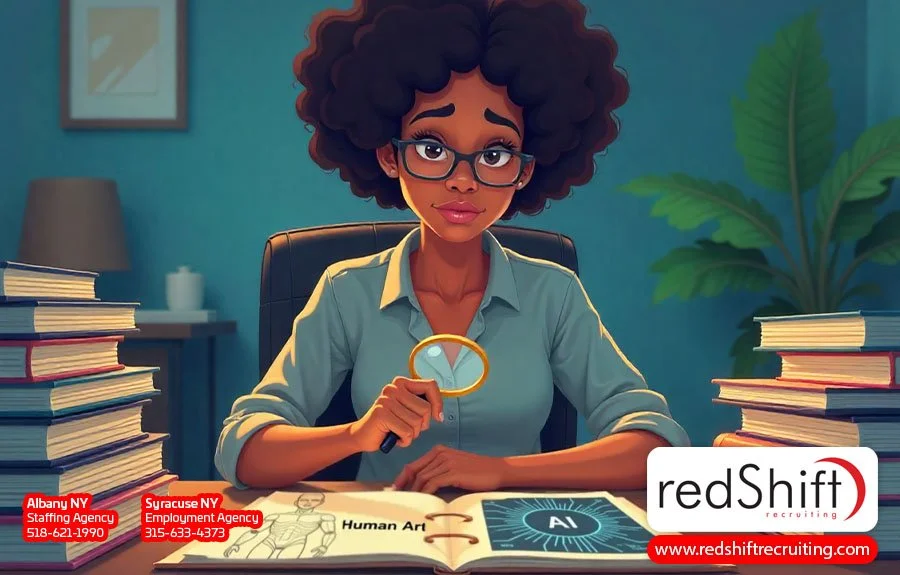
The Value of Human Skills and AI Skills
AI is creating new ways to make art, but it hasn't changed the fundamentals of what makes a great designer. Ultimately, employers still need to know if candidates can do the work.
Human Skills Versus AI Skills
Whether a candidate uses AI or not, fundamentals like composition and craft, typography, and design judgment remain non-negotiable. These are the skills that separate the true creative designer from the casual hobbyist, empowering them to recognize what works, what doesn't, and how to fix it. A candidate’s portfolio should reflect not just what they produced, but the intentional thinking and artistic vision that shaped it. AI's role should be to support problem-solving, explore new ideas, and foster creativity—it shouldn’t replace the effort, discipline, and intentional thinking that go into creating professional creative work. If a designer is treating AI as a shortcut instead of a tool, that’s a red flag.
At the same time, it’s important to recognize that AI skills aren't trivial. Creating professional results using AI tools demands significant time, effort, and practice. Far from a one-and-done prompt, it's a process of iteration, refinement, and editing. Prompting effectively is its own skill, demanding both technical ability and creativity. Strong candidates know how to use AI strategically, combining human fundamentals with technical direction to bring a concept to life.
How AI Enhances the Creative Process
While nothing can replace the human skills that go into the creative process, when guided by a skilled designer, AI helps speed things up. It can generate mood board variations, produce rough prototypes, or provide multiple directions for brainstorming sessions. It can also cut repetitive production time, spark fresh ideas, and streamline early drafts. This doesn’t just benefit the designer; it also makes collaboration easier by giving stakeholders more options, faster. In many cases, AI isn’t the final step at all—designers may use it to generate a base and then reshape, edit, and expand it in Photoshop or other tools, bringing their own judgment, artistic process, and creative flair to the work.
The strongest hires use new tools to make their workflow more efficient. They employ AI as an accelerator, not a crutch. The time saved gives them room to refine their ideas, tackle more complex challenges, and focus on the parts of design where human judgment matters most.
Finding the Right Balance
How much AI belongs in your business’s marketing, branding, or creative work depends on your company context. Some teams may welcome it for early ideation but restrict it from client-facing deliverables. Others may allow selective AI-generated content, while some may choose not to adopt it at all. Whatever your company’s policy toward AI image generation, the best candidates will be those who balance strong fundamental skills with curiosity and willingness to explore new tools. A commitment to staying up-to-date on technology is an important trait in any professional, ensuring their skills remain relevant as industry tools and expectations shift.
What all this means is that seeing AI-generated content in a portfolio shouldn’t automatically be a strike against a candidate. Take time to ask questions and understand their process and real abilities. The best hires bring mastery of traditional craft, the judgment to know when AI helps, and the discernment to understand when authentic creativity must take the lead.
AI art isn’t only changing portfolios—it’s also reshaping how companies attract and engage talent. Explore how visuals created with AI are helping employers strengthen their brand identity and stand out in a competitive market.
Read: How AI Images Can Transform Employer Branding 🖼️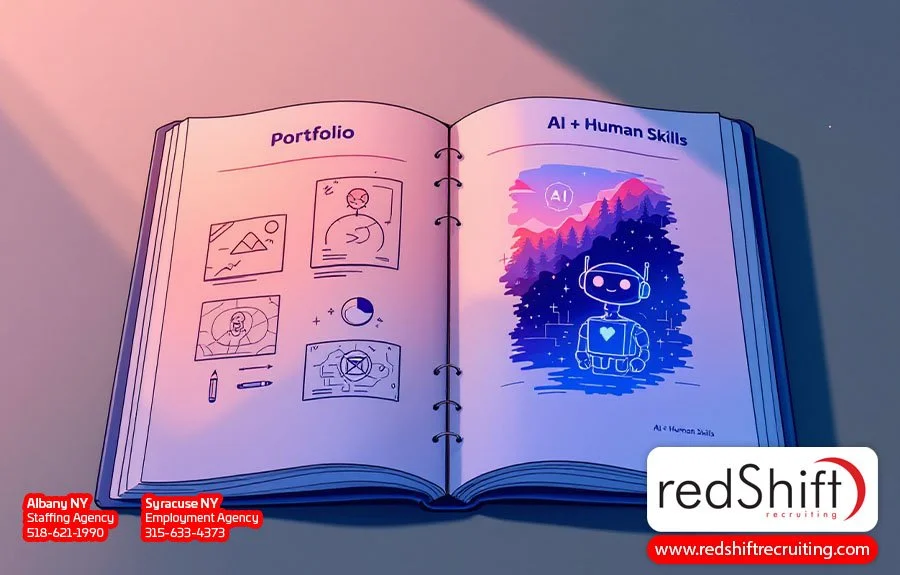
Identifying Real Skills (and Risk) in Creative Portfolios
So how do you assess real skills in a modern portfolio? Not every candidate will disclose exactly how they’ve used AI, and without obvious giveaways like distorted details or mismatched elements, it isn’t always easy to tell whether it was involved. It’s also important to recognize the wide range of opinions about AI tools—and check your own potential biases. The creative field is evolving quickly, and portfolios now reflect a wider mix of approaches. Some strong candidates avoid AI art altogether, whether for ethical reasons, client expectations, or simply a preference for traditional methods. Others use AI as just one of many tools in their creative process.
Both traditional skills and AI skills have value, and whether or not a candidate includes AI art in their creative portfolio should never be used as the sole indicator of their ability to succeed on the job. In this rapidly evolving industry, employers need to delve deeper to uncover evidence of real skill and authenticity. These signals can help you distinguish effective AI use from gaps in skill.
✅ Green Flags: Signs of a Strong Candidate
A strong portfolio often shows more than just finished pieces; it gives you a window into the designer’s thinking, skills, and artistic journey. Positive signals include:
-
Transparency about AI use: Makes clear notes on whether AI was part of the work, and if so, how.
-
Process evidence: Includes sketches, wireframes, drafts, or prompt logs that reveal the designer’s artistic process.
-
Range of skills: Balances traditional, digital, and AI-assisted work, proving adaptability.
-
Adaptability across projects: Applies skills consistently across branding, marketing, or digital design.
-
Clear storytelling and rationale: Provides a strong story behind choices, tied to client needs or challenges.
-
Unique artistic voice: Shows a candidate’s creative vision coming through regardless of tools.
-
Consistency of quality: Maintains steady standards across different projects, not just one standout piece.
-
Technical proficiency: Demonstrates fluency in industry-standard tools like Adobe, Figma, or Blender.
🚩 Red Flags: Signs of Concern
By contrast, certain patterns in a portfolio suggest a hiring risk—either because fundamental skills are missing or because AI is being used as a shortcut. Red flags to watch for include:
-
No process or explanation: Shows polished images without sketches, drafts, or any supporting detail.
-
Generic style: Features the unrefined “AI look,” lacking originality.
-
Inconsistent quality: Shows big skill gaps across pieces in the same AI art portfolio.
-
Overly perfect portfolios: Offers flawless results without any rough work, suggesting AI-only outputs.
-
Overemphasis on quantity: Packs in dozens of polished pieces with no depth, iteration, or case studies.
-
No disclosure: Fails to mention obvious AI use.
-
Over-reliance on AI: Uses prompts as a substitute for missing fundamentals.
-
Ethical or legal issues: Copies work directly from other artists or uses AI without clear licensing.
-
Shaky delivery: Produces a final result in live projects that doesn’t match the polished portfolio.
Green flags suggest candidates who blend strong fundamentals with smart use of AI, while red flags signal risks that could affect quality, time, or reputation. Keep in mind, these signals are guides, not absolutes—they’re most useful when you look for patterns, not single signs. Once you know what to watch for, the next step is learning how to evaluate portfolios in practice—asking the right questions and using the right methods to confirm real skills.
How to Evaluate Creative Portfolios With AI Art
Once you know what to watch for in a portfolio, the next step is confirming whether a candidate has the skills to succeed in your role. These steps help you go beyond surface polish and evaluate human creativity alongside AI-assisted work.
-
Set expectations in job descriptions: Be clear about your stance on AI use up front so candidates know what's acceptable.
-
Ask process-focused questions: Go deeper than the final piece. Ask candidates to explain their creative journey through questions like, “What part of this design was AI-assisted, and how did you refine it?” or “Can you give an example of how you iterated on this idea?”
-
Request process work: Ask to see supporting materials from their portfolio, such as sketches, drafts, wireframes, or prompt logs. These show how the piece evolved and demonstrate the candidate's ability to move from concept to execution.
-
Use small, practical tests: Keep skills tests short and relevant to the role. Even a mini assignment or timed exercise can reveal how a candidate thinks, adapts, and solves problems.
-
Check authenticity: Ask candidates to walk you through the steps behind a specific portfolio piece. This helps confirm that their process—not just the output—matches what they claim.
-
Look for the human voice: Originality and authentic creativity should shine through, even in projects where AI played a role.
-
Stay current: Familiarize yourself with AI tools, trends, and ethical guidelines so you can ask informed questions.
-
Partner with creative leads: Collaborate with design managers or art directors to establish evaluation criteria that help you interpret what you see.
By asking the right questions, requiring process evidence, and using small, practical tests, you can make confident decisions about which candidates truly have the skills to succeed.
Want a simple way to evaluate creative candidates more confidently?
Download our Creative Portfolio Evaluation Checklist — a quick, practical guide that helps you spot authentic skills, identify red and green flags, and ask the right questions during interviews.
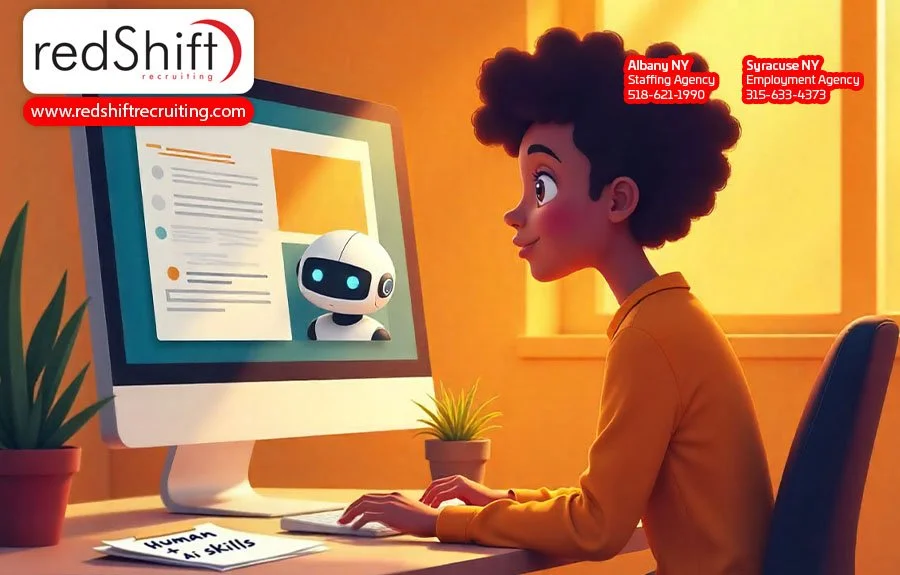
Frequently Asked Questions
How Can You Tell if AI Art Was Used Without Disclosure?
Spotting AI in a portfolio or on a creative site isn’t always obvious now that tools are improving. Look for artwork inconsistencies like mismatched lighting, awkward text rendering, or overly “perfect” symmetry. Ask candidates directly about their creative process and how they approached a piece—an honest explanation will reveal more than the image alone. Getting insights into how they worked matters more than “catching” them; you’re not policing, you’re confirming skills.
What Legal Risks Come With Hiring Designers Using AI Art?
AI can introduce risk if candidates are putting AI-generated pieces into client-facing work without checking licensing or originality. Some platforms have sparked debate over how their models are trained and whether their outputs might resemble existing works. For employers, this can mean copyright concerns, reputational damage, or disputes over ownership. The safest move is to clarify your stance in advance and ensure candidates understand your company’s standards.
Should AI Prompt Engineering Be Considered a Design Skill?
Yes—knowing how to “talk to” AI tools is becoming a real and highly valued skill. Strong designers use prompting as part of their artistic process, combining technical inputs with human judgment to create something unique and engaging. While prompt engineering shouldn’t take center stage over fundamentals like composition and typography, it can open new opportunities for ideation and speed. A candidate who can balance both is more versatile than someone who can only do one or the other.
How Do Design Tests Expose Over-Reliance on AI Tools?
Well-designed tests help employers see how candidates actually think. Instead of asking them to write long reports or build a whole campaign, give a short exercise—a logo variation, a quick layout sketch, or a 20-minute brainstorm. Candidates who stand out will show adaptability, problem-solving, and original thinking, not just polished outputs. This approach lets you see whether they can create under time limits and client direction, rather than leaning entirely on AI.
What Tools Can Detect AI-Generated Images in Portfolios?
A few emerging platforms claim to flag AI content, but none are foolproof. Think of them as an extra data point rather than a final verdict. The best detection still comes from human review: talking through the creative journey, checking for process evidence, and asking candidates to explain specific choices. Collaboration with your design group or art directors will give you stronger evaluations than relying on software alone. Detection tools can help analyze a designer’s or artist’s artwork, but they shouldn’t replace professional judgment.
Final Thoughts
AI is reshaping how portfolios may look in the future, but it doesn’t change the core of creative hiring: finding people with genuine skill, originality, and judgment. The best candidates will use AI responsibly to enhance their process, while still demonstrating the fundamentals your role requires.
For employers, the challenge isn’t spotting AI for its own sake—it’s spotting whether a candidate has the creativity and ability to do the job. By focusing on process, asking the right questions, and watching for clear signals, you can identify real talent in a world where human and AI creativity often overlap.
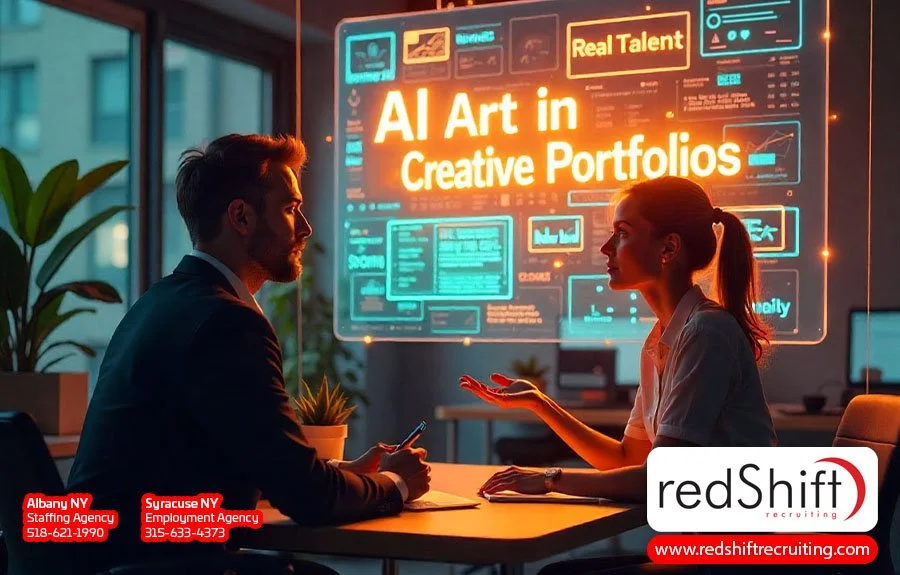

Article Author:
Ashley Meyer
Digital Marketing Strategist
Albany, NY
from Career Blog: Resources for Building a Career - redShift Recruiting https://www.redshiftrecruiting.com/career-blog/ai-art-in-creative-portfolios
via redShift Recruiting
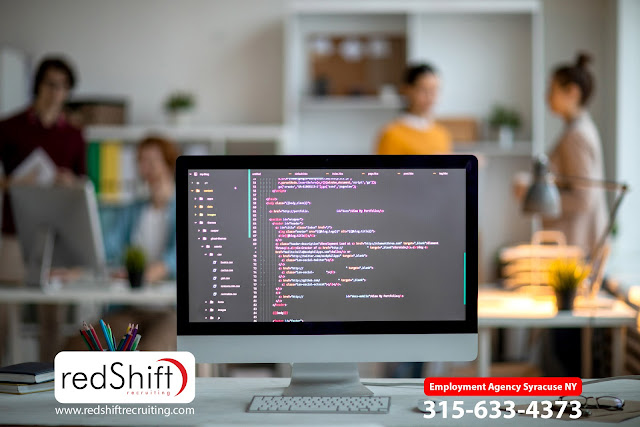
Comments
Post a Comment